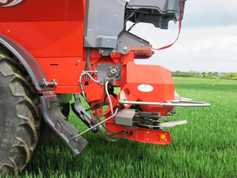At the soil fertility conference in Clonmel yesterday, 16 October, a worrying statistic revealed that approximately two-thirds of Irish soils have a low pH. According to David Wall from Teagasc, Johnstown Castle, every drop in pH has a huge effect on plant growth. “Roots growing in very acidic soils injure easily and become ‘leaky’, the roots will take nutrients in but will lose them just as easily,” he explained. He said roots growing in low pH conditions become stunted and don’t grow as well as neutral pH soils and that is why new reseeds find it very difficult to become established and survive in acidic soils. Liming is the best way to increase the pH of acidic soils and its application has many benefits:
It increases grass production.Up to 80kg/ha/year of soil nitrogen is released.A balanced pH (6.3 to 6.5) increases the availability of P, K and micronutrients.When chemical and organic manures are applied, the response rate will be increased.Heavy soils can also benefit from lime application. Teagasc adviser Ger Courtney says the farms in the Heavy Soils Programme currently have a low pH of 5.71. These farms are low because they are losing 500kg/ha/year due to being in high rainfall areas. He says these farmers now plan to take a little-and-often approach with their lime applications to ensure that pH rises and trafficability isn’t curtailed. With increased pH and good fertility levels, they should be on target to produce 12t DM/ha/year.
At the soil fertility conference in Clonmel yesterday, 16 October, a worrying statistic revealed that approximately two-thirds of Irish soils have a low pH. According to David Wall from Teagasc, Johnstown Castle, every drop in pH has a huge effect on plant growth. “Roots growing in very acidic soils injure easily and become ‘leaky’, the roots will take nutrients in but will lose them just as easily,” he explained. He said roots growing in low pH conditions become stunted and don’t grow as well as neutral pH soils and that is why new reseeds find it very difficult to become established and survive in acidic soils. Liming is the best way to increase the pH of acidic soils and its application has many benefits:
It increases grass production.Up to 80kg/ha/year of soil nitrogen is released.A balanced pH (6.3 to 6.5) increases the availability of P, K and micronutrients.When chemical and organic manures are applied, the response rate will be increased.Heavy soils can also benefit from lime application. Teagasc adviser Ger Courtney says the farms in the Heavy Soils Programme currently have a low pH of 5.71. These farms are low because they are losing 500kg/ha/year due to being in high rainfall areas. He says these farmers now plan to take a little-and-often approach with their lime applications to ensure that pH rises and trafficability isn’t curtailed. With increased pH and good fertility levels, they should be on target to produce 12t DM/ha/year.






 This is a subscriber-only article
This is a subscriber-only article











SHARING OPTIONS: